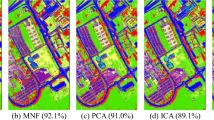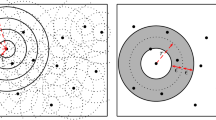Abstract
The algorithmic approach to data modelling has developed rapidly these last years, in particular methods based on data mining and machine learning have been used in a growing number of applications. These methods follow a data-driven methodology, aiming at providing the best possible generalization and predictive abilities instead of concentrating on the properties of the data model. One of the most successful groups of such methods is known as Support Vector algorithms. Following the fruitful developments in applying Support Vector algorithms to spatial data, this paper introduces a new extension of the traditional support vector regression (SVR) algorithm. This extension allows for the simultaneous modelling of environmental data at several spatial scales. The joint influence of environmental processes presenting different patterns at different scales is here learned automatically from data, providing the optimum mixture of short and large-scale models. The method is adaptive to the spatial scale of the data. With this advantage, it can provide efficient means to model local anomalies that may typically arise in situations at an early phase of an environmental emergency. However, the proposed approach still requires some prior knowledge on the possible existence of such short-scale patterns. This is a possible limitation of the method for its implementation in early warning systems. The purpose of this paper is to present the multi-scale SVR model and to illustrate its use with an application to the mapping of Cs137 activity given the measurements taken in the region of Briansk following the Chernobyl accident.











Similar content being viewed by others
References
Aronszajn N (1950) Theory of reproducing kernels. Trans Am Math Soc 68:337–404
Bhattacharya B, Solomatine D (2006) Machine learning in soil classification. Neural Netw 19(2):186–195
Bi J, Zhang T, Bennett K (2004) Column-generation boosting methods for mixture of kernels. In: Proceedings of ACM SIGKDD international conference on knowledge discovery and data mining (SIGKDD’04), pp 521–526
Boser B, Guyon I, Vapnik V (1992) A training algorithm for optimal margin classifiers. Fifth annual workshop on computational learning theory. ACM Press, Pittsburgh
Breiman L (2001) Statistical modeling: the two cultures. Stat Sci 16(3):199–231
Brenning A (2005) Spatial prediction models for landslide hazards: review, comparison and evaluation. Nat Hazards Earth Syst Sci 5:853–862
Burges C (1998) A tutorial on support vector machines for pattern recognition. Data Min Knowl Discov 2(2):121–167
Cherkassky V, Mullier F (1998) Learning from data. Wiley, New York
Cherkassky V, Krasnopolsky M, Solomatine D, Valdés J (2006) Introduction to special issue: earth sciences and environmental applications of computational intelligence. Neural Netw 19(2):111
Chernobyl Accident Results and Problems in Eliminating Its Consequences in Russia 1986–2001, Russian National Report (2001). http://www.ibrae.ac.ru/english/natrep-2001.htm
Chiles J-P, Delfiner P (1999) Geostatistics: modeling spatial uncertainty. In: Probability and statistics, Wiley Series
Christakos G (2000) Modern Spatiotemporal Geostatistics. Oxford University Press, New York
Cressie N (1993) Statistics for spatial data (Revised edition). Wiley, New York
Cristianini N, Shawe-Taylor J (2000) An introduction to support vector machines and other kernel-based learning methods. Cambridge University Press, Cambridge
Cortes C, Vapnik V (1995), support vector networks. Mach Learn 20:273–297
Deutsch CV, Journel AG (1997) GSLIB. Geostatistical software library and user’s guide. Oxford University Press, New York
Hastie T, Tibshirani R, Friedman J (2001) The elements of statistical learning. Springer, Heidelberg
Huber P (1964) Robust estimation of location parameter. Ann Math Stat 35(1)
Kanevski M, Canu S (2000) Spatial data mapping with support vector regression, IDIAP Research Report, RR-00-09
Kanevski M, Maignan M (2004) Analysis and modelling of spatial environmental data. EPFL Press
Kanevski M, Arutyunyan R, Bolshov L, Demyanov V, Maignan M (1996) Artificial neural networks and spatial estimations of Chernobyl fallout. Geoinformatics 7(1):5–11
Kanevski M, Pozdnoukhov A, Canu S, Maignan M (2002a) Advanced spatial data analysis and modelling with support vector machines. Int J Fuzzy Syst 4(1):606–616
Kanevski M, Parkin R, Pozdnoukhov A, Timonin V, Maignan M, Yatsalo B, Canu S (2002b) Environmental data mining and modelling based on machine learning algorithms and geostatistics. In: International environmental modelling and software society conference (iEMSs2002) Lugano, Switzerland, pp 414–419
Kuncheva L (2004) Combining pattern classifiers. Wiley, New Jersey
Meyer D, Leisch F, Hornik K (2003) The support vector machine under test. Neurocomputing, 55:169–186
Nix DA, Weigend AS (1995) Learning local error bars for non-linear regression. In: Proceedings of NIPS 7, pp 489–496
Pai P-F, Hong W-C (2007) A recurrent support vector regression model in rainfall forecasting. Hydrol Process 21(6):819–827
Pozdnoukhov A (2005) Support vector regression for automated robust spatial mapping of natural radioactivity. Applied GIS 1(2):21-01–21-10
Pozdnoukhov A, Kanevski M (2006) Monitoring network optimisation for spatial data classification using support vector machines. Int J of Environ Pollut 28(3/4):465–484
Pozdnoukhov A, Kanevski M, Purves RS (2007) Avalanche danger forecasting with machine learning methods. Geophys Res Abstr 9:01917, EGU
Rasmussen CE, Williams C (2006) Gaussian processes for machine learning. MIT press, Cambridge
Savelieva E, Demyanov V, Kanevski M, Serre M, Christakos G (2005) BME-based uncertainty assessment of the Chernobyl fallout. Geoderma 128:312–324
Smola A, Scholkopf B (2004) A tutorial on support vector regression. Stat Comput 14:199–222
Scholkopf B, Smola A (2002) Learning with kernels: support vector machines, regularization, optimization, and beyond. MIT Press, Cambridge
Specht DF (1991) A generalized regression neural network. IEEE Trans Neural Netw 2:568–576
Sonnenburg S, Raetsch G, Schaefer C, Scholkopf B (2006) Large scale multiple kernel learning. In: Bennett K, Hernandez EP (eds) J Mach Learn Res 7:1531–1565
Tikhonov AN, Arsenin VY (1977) Solutions of Ill-posed problems, Wiley, New York
Timonin V, Savelieva E (2005) Spatial prediction of radioactivity using general regression neural network. Appl GIS 1(2):19-01–19-14
Vapnik V (1995) The nature of statistical learning theory. Springer, Heidelberg
Vapnik V (1998) Statistical learning theory. Wiley, New York
Weston J (1999) Extensions to the support vector method. PhD Thesis, Royal Holloway University of London
Weston J, Gammerman A, Stitson M, Vapnik V, Vovk V, Watkins C (1999) Support vector density estimation. In: Schölkopf B, Burges CJC, Smola AJ (Eds) Advances in kernel methods-support vector learning. MIT Press, Cambridge, pp 293–306
Acknowledgments
The research was supported by Swiss National Science Foundation projects “GeoKernels: Kernel-Based Methods for Geo- and Environmental Sciences” (project No. 200021-113944). The authors would like to thank Gregoire Dubois and an anonymous reviewer for helpful comments and suggestions.
Author information
Authors and Affiliations
Corresponding author
Rights and permissions
About this article
Cite this article
Pozdnoukhov, A., Kanevski, M. Multi-scale support vector algorithms for hot spot detection and modelling. Stoch Environ Res Risk Assess 22, 647–660 (2008). https://doi.org/10.1007/s00477-007-0162-x
Published:
Issue Date:
DOI: https://doi.org/10.1007/s00477-007-0162-x




